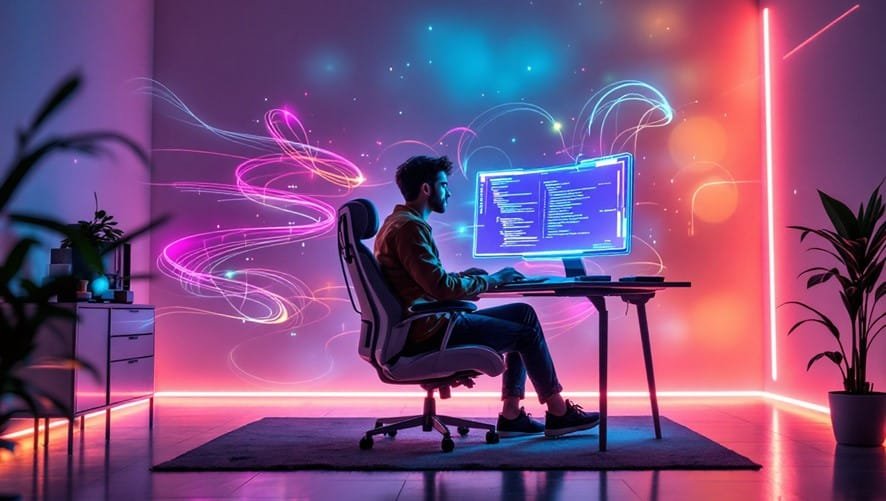Programming has traditionally been like painting or sculpting, requiring developers to master complex syntax and logic to build software. But a new approach, vibe coding, is challenging this norm.
Vibe coding lets creators describe their ideas in plain language, like “a sleek app with a dark theme”. The AI then generates the necessary code, bypassing manual programming. The programmer just waves the wand, and the work is done, or so it seems.
According to Forbes, many of the startups raising money have about 85 percent of their entire code generated by AI. By automating code creation, it raises a bold question: could vibe coding replace human programming entirely, especially for routine tasks or simple projects?
This blog post dives into whether vibe coding spells the end of traditional programming or marks a fresh start.
What Is Vibe Coding and Why It’s Gaining Traction
Vibe coding is about capturing a project’s intent without touching a line of code. This method is gaining ground because it opens creation to non-coders, from entrepreneurs to designers, while speeding up workflows for seasoned developers.
For example, a gaming developer can simply ‘talk’ to AI to generate a working mobile video game based on a hand-drawn illustration.
Beyond prototyping, vibe coding powers conversational interfaces that interpret plain-language briefs and apps that turn napkin sketches into working code. It’s catching on because it cuts through technical barriers, letting ideas flow freely and reducing the time from concept to reality.
How AI Is Rewriting the Developer’s Role
AI is reshaping what it means to be a developer. Coding once demanded years of mastering languages like Python or C++, but now, AI tools let beginners turn ideas into functional products with minimal technical know-how.
Developers are pivoting from writing every line of code to acting as product architects, refining AI-generated outputs to align with their goals. A Forbes report shows that AI has the potential to cut product development time by three years.
For instance, a developer might use AI to draft a web app’s frontend, then focus on optimizing its logic or user flow. This co-creation model emphasizes strategy over syntax, letting developers tackle bigger-picture challenges.
It also democratizes tech, enabling non-technical founders to join the game, though it raises questions about how deep technical skills will remain essential.
How Builders Use AI Tools
Vibe coding relies on tools that value intuition over coding expertise. These platforms let users describe their ideas in plain words and get working results quickly. Hocoos points out that AI can take a simple description, like a website’s tone or layout, and turn it into a functional site.
For example, a freelancer might outline a portfolio page’s purpose and style, and AI delivers a ready-to-use site, leaving room for personal touches. Startups testing app ideas can use these tools to mock up interfaces and gather feedback quickly.
This approach feels less like traditional coding and more like collaborating with a creative partner, empowering builders to experiment and refine without needing deep technical skills.
Is This the End of Programming or a New Beginning?
Vibe coding isn’t the end of programming, yet. It’s more of a turning point. AI excels at repetitive tasks, like generating basic layouts or boilerplate code, but complex systems, like secure databases or intricate algorithms, still need human engineers.
A report found that many programmers are able to get the first 70 percent of the coding work using AI. However, the rest of the 30 percent is more complex. As IBM points out, vibe coding often leads to debugging challenges, as the code lacks architecture.
Also, scaling those projects or adding custom features often demands coding expertise. Vibe coding shines for quick starts and iterative experiments, but traditional programming remains vital for depth and precision.
The future likely blends both: AI for speed, humans for strategy.
What Builders and Developers Should Focus on Now
As vibe coding redefines development, builders must hone new skills to stay ahead. Systems thinking, which means understanding how a project’s pieces fit together, is more important than ever, ensuring AI outputs align with the big picture.
Writing clear, precise prompts for AI is a craft, turning vague ideas into actionable results. It is also crucial to design logical flows to prevent errors in user experience.
A 2025 BrainHub study says that developers now prioritize problem-solving and analytical soft skills over pure coding. Beyond technical skills, developers should sharpen their ability to translate business needs into technical requirements, acting as bridges between AI and real-world goals.
Human oversight keeps AI grounded, ensuring projects solve actual problems.
Less Code, More Creation
AI isn’t erasing programming. It’s making it more open and creative. Vibe coding strips away the technical slog, letting builders focus on ideas over syntax. It’s a new entry point for innovation, with engineering still anchoring the core.
Both seasoned coders and first-time builders need to use AI tools to develop software. Share your vision, let AI handle the grunt work, and start creating. Your next project is closer than you think.



